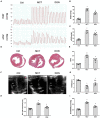Donepezil Ameliorates Pulmonary Arterial Hypertension by Inhibiting M2-Macrophage Activation
- PMID: 33791350
- PMCID: PMC8005547
- DOI: 10.3389/fcvm.2021.639541
Donepezil Ameliorates Pulmonary Arterial Hypertension by Inhibiting M2-Macrophage Activation
Abstract
Background: The beneficial effects of parasympathetic stimulation in pulmonary arterial hypertension (PAH) have been reported. However, the specific mechanism has not been completely clarified. Donepezil, an oral cholinesterase inhibitor, enhances parasympathetic activity by inhibiting acetylcholinesterase, whose therapeutic effects in PAH and its mechanism deserve to be investigated. Methods: The PAH model was established by a single intraperitoneal injection of monocrotaline (MCT, 50 mg/kg) in adult male Sprague-Dawley rats. Donepezil was administered via intraperitoneal injection daily after 1 week of MCT administration. At the end of the study, PAH status was confirmed by echocardiography and hemodynamic measurement. Testing for acetylcholinesterase activity and cholinergic receptor expression was used to evaluate parasympathetic activity. Indicators of pulmonary arterial remodeling and right ventricular (RV) dysfunction were assayed. The proliferative and apoptotic ability of pulmonary arterial smooth muscle cells (PASMCs), inflammatory reaction, macrophage infiltration in the lung, and activation of bone marrow-derived macrophages (BMDMs) were also tested. PASMCs from the MCT-treated rats were co-cultured with the supernatant of BMDMs treated with donepezil, and then, the proliferation and apoptosis of PASMCs were evaluated. Results: Donepezil treatment effectively enhanced parasympathetic activity. Furthermore, it markedly reduced mean pulmonary arterial pressure and RV systolic pressure in the MCT-treated rats, as well as reversed pulmonary arterial remodeling and RV dysfunction. Donepezil also reduced the proliferation and promoted the apoptosis of PASMCs in the MCT-treated rats. In addition, it suppressed the inflammatory response and macrophage activation in both lung tissue and BMDMs in the model rats. More importantly, donepezil reduced the proliferation and promoted the apoptosis of PASMCs by suppressing M2-macrophage activation. Conclusion: Donepezil could prevent pulmonary vascular and RV remodeling, thereby reversing PAH progression. Moreover, enhancement of the parasympathetic activity could reduce the proliferation and promote the apoptosis of PASMCs in PAH by suppressing M2-macrophage activation.
Keywords: M2-macrophage; cholinesterase inhibitor; donepezil; pulmonary arterial hypertension; pulmonary arterial smooth muscle cells.
Copyright © 2021 Qiu, Zhang, Li, Jiang, Guo, He and Guo.
Conflict of interest statement
The authors declare that the research was conducted in the absence of any commercial or financial relationships that could be construed as a potential conflict of interest.
Figures








Similar articles
-
Serum-glucocorticoid regulated kinase 1 regulates macrophage recruitment and activation contributing to monocrotaline-induced pulmonary arterial hypertension.Cardiovasc Toxicol. 2014 Dec;14(4):368-78. doi: 10.1007/s12012-014-9260-4. Cardiovasc Toxicol. 2014. PMID: 24825325
-
Calcineurin/NFAT Signaling Modulates Pulmonary Artery Smooth Muscle Cell Proliferation, Migration and Apoptosis in Monocrotaline-Induced Pulmonary Arterial Hypertension Rats.Cell Physiol Biochem. 2018;49(1):172-189. doi: 10.1159/000492852. Epub 2018 Aug 22. Cell Physiol Biochem. 2018. PMID: 30134231
-
Regulatory effects of Prohibitin 1 on proliferation and apoptosis of pulmonary arterial smooth muscle cells in monocrotaline-induced PAH rats.Life Sci. 2020 Jun 1;250:117548. doi: 10.1016/j.lfs.2020.117548. Epub 2020 Mar 12. Life Sci. 2020. PMID: 32173312
-
Inhibition of glutaminase 1 reduces M1 macrophage polarization to protect against monocrotaline-induced pulmonary arterial hypertension.Immunol Lett. 2025 Apr;272:106974. doi: 10.1016/j.imlet.2025.106974. Epub 2025 Jan 5. Immunol Lett. 2025. PMID: 39765314
-
Contribution of Impaired Parasympathetic Activity to Right Ventricular Dysfunction and Pulmonary Vascular Remodeling in Pulmonary Arterial Hypertension.Circulation. 2018 Feb 27;137(9):910-924. doi: 10.1161/CIRCULATIONAHA.117.027451. Epub 2017 Nov 22. Circulation. 2018. PMID: 29167228
Cited by
-
Inhibition of Th17 cells by donepezil ameliorates experimental lung fibrosis and pulmonary hypertension.Theranostics. 2023 Mar 21;13(6):1826-1842. doi: 10.7150/thno.82069. eCollection 2023. Theranostics. 2023. PMID: 37064881 Free PMC article.
-
Role of macrophages in pulmonary arterial hypertension.Front Immunol. 2023 Apr 19;14:1152881. doi: 10.3389/fimmu.2023.1152881. eCollection 2023. Front Immunol. 2023. PMID: 37153557 Free PMC article. Review.
-
Detection of pathogenic gram-negative bacteria using an antimicrobial peptides-modified bipolar electrode-electrochemiluminescence platform.Mikrochim Acta. 2024 Oct 5;191(11):648. doi: 10.1007/s00604-024-06685-7. Mikrochim Acta. 2024. PMID: 39367972
-
Dysregulated fatty acid metabolism in pericardiac adipose tissue of pulmonary hypertension due to left heart disease mice.FASEB J. 2025 Feb 15;39(3):e70355. doi: 10.1096/fj.202402842R. FASEB J. 2025. PMID: 39932146 Free PMC article.
-
Y-Chromosome Gene, Uty, Protects Against Pulmonary Hypertension by Reducing Proinflammatory Chemokines.Am J Respir Crit Care Med. 2022 Jul 15;206(2):186-196. doi: 10.1164/rccm.202110-2309OC. Am J Respir Crit Care Med. 2022. PMID: 35504005 Free PMC article.
References
LinkOut - more resources
Full Text Sources
Other Literature Sources

